4-D Glasses
Ann Klefstad has spent hours pondering Julie Buffalohead's paintings, on view now at Bockley Gallery in Minneapolis; read on for her take on the artist's new work, whose playful charm disguises a keen, sometimes dark eye for cultural observation.

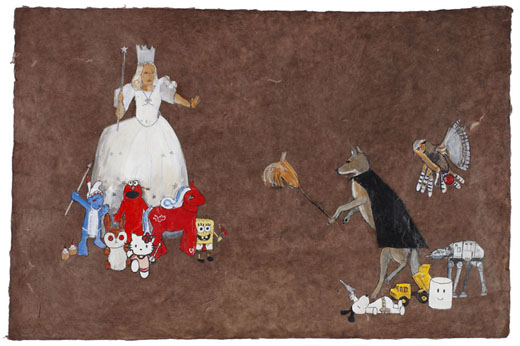
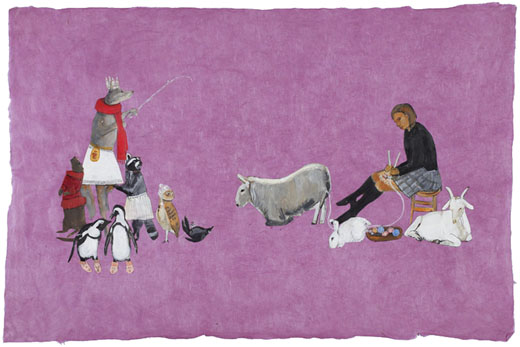

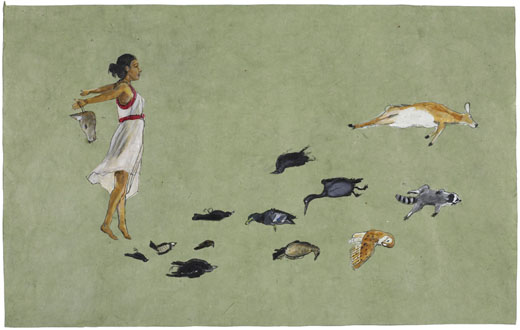
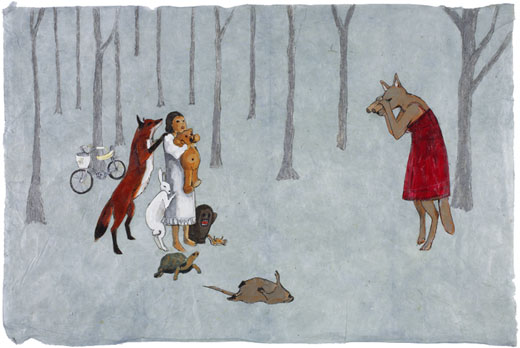
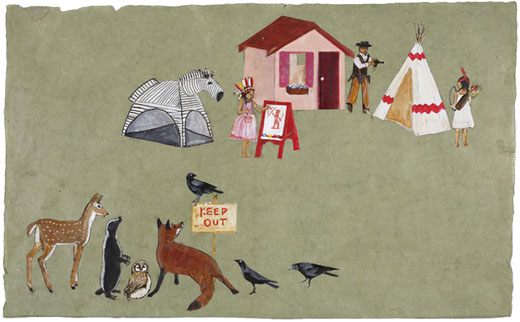
JULIE BUFFALOHEAD’S NEW PAINTINGS AT THE BOCKLEY GALLERY seem charming at first. They don’t lose their charm upon closer examination, but their disguised powers become evident.
Fairly small works on paper (22″ x 30″), the paintings are collaged. Small figures — drawn and painted with acrylic with a slightly crude edge, cut out and glued down — give a crafted edge to these compositions, which are arranged on colored sheets of handmade paper. That is, an aura of childhood, or at least domesticity, hovers around the choices Buffalohead has made.
Some of the icons depicted — Barbies, Uglydolls, Star Wars toys — are drawn from a collective, commercial childhood that most of us likely had bought for us. Other images — the good witch from The Wizard of Oz, the Three Blind Mice — are plucked from texts that the dominant culture has produced around childhood. Yet others in the mix are wild or feral, animals from this region, deer, wolves, foxes, rodents. Some of the animals are dead or felled; a croaked woodchuck is somehow the most affecting of these, for me. And still other animals appear as masks.
The people in these paintings feel very specific, and may well be depictions of the artist. These people often are shown wearing animal masks; children in Buffalohead’s images sometimes wear animal ears. In so doing, the humans are adopting another nature — they are transformed and also transformers — they can become others. In one image, The Medusa Syndrome, named for the transformed woman in Greek mythology whose gaze turned people into stone, the unmasked face of a young woman has apparently felled a swath of animals, and she leaps toward them — in glee? Aggression? In an attempt to mitigate the damage she’s caused?
This idea of a double nature — and that of the related, potential dangers that accompany such a state — floats through Buffalohead’s images like smoke. Still, these pieces are playful, often funny, even if they’re also sometimes mortally dark. I don’t want to “read” them for you, because no one interpretation stays put for long. I’ve spent hours looking at these in slide-show format, and as they recur before my eyes, any previous reading I’ve settled on for them vanishes, to be replaced by another. The images are truly protean, constantly shifting, their various cultural signifiers and leads into the animal world stepping forward and back, like dancers weaving a pattern that is then unwoven the next moment.
______________________________________________________
Buffalohead has the 4-D vision that comes with not mere bi-culturality, but with an intimate knowledge of the precursor culture, which is still current — maybe it’s like being an Italian whose family was in the Roman senate, and still tells stories about it.
______________________________________________________
I DON’T WANT TO REDUCTIVELY describe Julie Buffalohead as a Native artist. Nor do I want to describe the work of Jim Denomie, Andrea Carlson, Star Wallowing Bull, as solely or even primarily Native art. But these artists do have a worldview with relevance for the enlarging of the art world.
Julie Buffalohead, along with the other artists listed above, is a Minnesota artist, a postmodern artist, a well-trained artist, an American artist, a world-class artist. But she (along with Denomie, Carlson, and Star Wallowing Bull) has an extra trait, too: she has the 4-D vision that comes with not mere bi-culturality, but with an intimate knowledge of the precursor culture, which is still current. Perhaps it’s like being an Italian whose family was in the Roman senate, and still tells stories about it.
Judging by the work these artists do — which is diverse, but sharing this one characteristic — they appear to have an especially acute eye for cultural memes, those icons that contain concentrated dollops of what somehow matters to us as a society. It seems as if the 4-D vision — 3-D with the addition of cultural farseeing, an ability to see outside of the dominant order — makes such memes leap forward in sharp outline, like blue Avatar creatures.
Buffalohead’s show at Bockley Gallery is a self-consistent text that’s open at both ends, taking in and transforming cultural signifiers, picking them up and turning them over, mixing and re-aligning memes in ways that show their odd contours — that at once appropriate and re-alienate them, so as to see them anew. And her work does this in ways that are not static: each familiar meme seems a little different every time you see it. It’s a little dizzying. Given that — when you go to the gallery, make sure you have time to look at the array of images more than twice.
______________________________________________________
Related exhibition details:
Julie Buffalohead: Paintings will be on view at Bockley Gallery in Minneapolis through October 9. You can see more of this artist’s work, find gallery hours and additional information about the show on the gallery website.
______________________________________________________
About the author: Ann Klefstad is an artist and writer in Duluth.